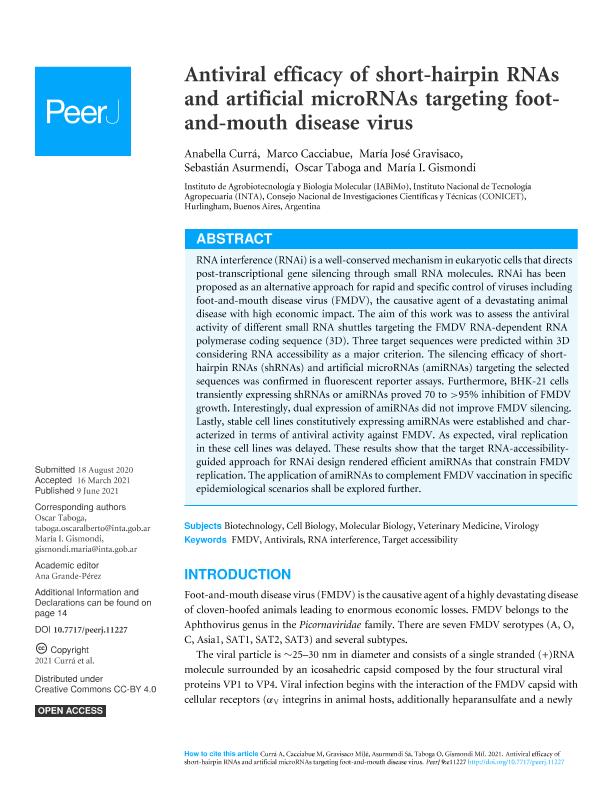Artículo
Antiviral efficacy of short-hairpin RNAs and artificial microRNAs targeting footand- mouth disease virus
Currá, Anabella Paola ; Cacciabue, Marco Polo Domingo
; Cacciabue, Marco Polo Domingo ; Gravisaco, María José; Asurmendi, Sebastian
; Gravisaco, María José; Asurmendi, Sebastian ; Taboga, Oscar Alberto
; Taboga, Oscar Alberto ; Gismondi, Maria Ines
; Gismondi, Maria Ines
 ; Cacciabue, Marco Polo Domingo
; Cacciabue, Marco Polo Domingo ; Gravisaco, María José; Asurmendi, Sebastian
; Gravisaco, María José; Asurmendi, Sebastian ; Taboga, Oscar Alberto
; Taboga, Oscar Alberto ; Gismondi, Maria Ines
; Gismondi, Maria Ines
Fecha de publicación:
06/2021
Editorial:
PeerJ Inc
Revista:
PeerJ
ISSN:
2167-8359
Idioma:
Inglés
Tipo de recurso:
Artículo publicado
Clasificación temática:
Resumen
RNA interference (RNAi) is a well-conserved mechanism in eukaryotic cells that directs post-transcriptional gene silencing through small RNA molecules. RNAi has been proposed as an alternative approach for rapid and specific control of viruses including foot-and-mouth disease virus (FMDV), the causative agent of a devastating animal disease with high economic impact. The aim of this work was to assess the antiviral activity of different small RNA shuttles targeting the FMDV RNA-dependent RNA polymerase coding sequence (3D). Three target sequences were predicted within 3D considering RNA accessibility as a major criterion. The silencing efficacy of shorthairpin RNAs (shRNAs) and artificial microRNAs (amiRNAs) targeting the selected sequences was confirmed in fluorescent reporter assays. Furthermore, BHK-21 cells transiently expressing shRNAs or amiRNAs proved 70 to >95% inhibition of FMDV growth. Interestingly, dual expression of amiRNAs did not improve FMDV silencing. Lastly, stable cell lines constitutively expressing amiRNAs were established and characterized in terms of antiviral activity against FMDV. As expected, viral replication in these cell lines was delayed. These results show that the target RNA-accessibilityguided approach for RNAi design rendered efficient amiRNAs that constrain FMDV replication. The application of amiRNAs to complement FMDV vaccination in specific epidemiological scenarios shall be explored further.
Palabras clave:
ANTIVIRALS
,
FMDV
,
RNA INTERFERENCE
,
TARGET ACCESSIBILITY
Archivos asociados
Licencia
Identificadores
Colecciones
Articulos (IABIMO)
Articulos de INSTITUTO DE AGROBIOTECNOLOGIA Y BIOLOGIA MOLECULAR
Articulos de INSTITUTO DE AGROBIOTECNOLOGIA Y BIOLOGIA MOLECULAR
Citación
Currá, Anabella Paola; Cacciabue, Marco Polo Domingo; Gravisaco, María José; Asurmendi, Sebastian; Taboga, Oscar Alberto; et al.; Antiviral efficacy of short-hairpin RNAs and artificial microRNAs targeting footand- mouth disease virus; PeerJ Inc; PeerJ; 9; 6-2021; 1-18
Compartir
Altmétricas



